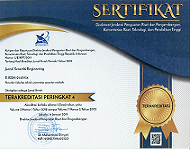Efektivitas Komposter Otomatis dengan Modifikasi Pipa Sirkulasi dan Bioaktivator Air Cucian Beras
Keywords:
Komposter otomatis, pipa sirkulasi, bioaktivator, air cucian beras, suhu, kualitas komposAbstract
This study aims to evaluate the effectiveness of an automatic composter based on temperature sensors and microcontroller-driven stirrers, equipped with modified air circulation pipes, in producing high-quality compost using rice washing water as a bioactivator. The method involved a 21-day aerobic composting process utilizing three types of air circulation pipe designs (control, L-shape, and U-shape), with and without the addition of the bioactivator. The materials used included a mixture of market vegetable waste, sawdust, and rice washing water. Parameters observed included temperature, pH, moisture content, organic carbon (C), total nitrogen (N), phosphate (P₂O₅), potassium (K₂O), and C/N ratio. The results showed that the automatic system effectively maintained temperatures in the range of 30–33°C and facilitated a stable decomposition process. The U-shaped circulation pipe design yielded the most optimal results, particularly in temperature control, moisture retention, and achieving a C/N ratio of 12.62 by day 21. The addition of rice washing water as a bioactivator also accelerated decomposition and enhanced the compost's nutrient content. Overall, the integration of the U-shaped pipe design with a temperature sensor-based automatic system significantly improved composting effectiveness and efficiency, producing compost that meets the SNI 19-7030-2004 standard.
References
[1] N. Salman, “Potensi Serbuk Gergaji Sebagai Bahan Pupuk Kompos,” J. Komposit, vol. 4, no. 1, p. 1, 2022, doi: 10.32832/komposit.v4i1.3695.
[2] S. A. Nabila, A. A. Muayyadi, and I. H. Santoso, “Monitoring Kontrol Suhu Dan Kelembaban Pada Pembuatan Kompos Berbasis Internet of Things,” e-Proceeding Eng., vol. 10, no. 5, pp. 4225–4230, 2023.
[3] A. Akhmad, N. Ulhasanah, and M. M. Sari, “Desain Komposter Sampah Pasar sebagai Solusi Persampahan di Negara Berkembang ( Studi Kasus : Jakarta, Indonesia ),” vol. 20, no. 2, pp. 356–364, 2022, doi: 10.14710/jil.20.2.356-364.
[4] S. W. Siagian, Y. Yuriandala, and F. B. Maziya, “Analisis Suhu, Ph Dan Kuantitas Kompos Hasil Pengomposan Reaktor Aerob Termodifikasi Dari Sampah Sisa Makanan Dan Sampah Buah,” J. Sains &Teknologi Lingkung., vol. 13, no. 2, 2021, doi: 10.20885/jstl.vol13.iss2.art7.
[5] E. KURNIATI, F. Anugroho, and A. A. Sulianto, “Analisis Pengaruh pH dan Suhu pada Desinfeksi Air Menggunakan Microbubbble dan Karbondioksida Bertekanan,” J. Pengelolaan Sumberd. Alam dan Lingkung. (Journal Nat. Resour. Environ. Manag., vol. 10, no. 2, pp. 247–256, 2020, doi: 10.29244/jpsl.10.2.247-256.
[6] F. Kaswinarni and A. A. S. Nugraha, “Kadar Fosfor, Kalium dan Sifat Fisik Pupuk Kompos Sampah Organik Pasar dengan Penambahan Starter EM4, Kotoran Sapi dan Kotoran Ayam,” Titian Ilmu J. Ilm. Multi Sci., vol. 12, no. 1, pp. 1–6, 2020, doi: 10.30599/jti.v12i1.534.
[7] Hermawansyah Dony, “Analisis Parameter Fisik Kompos Menggunakan Metode Vermikomposting Pada Sampah Daun Kering,” 2021.
[8] Deny Setiawati dan Elfarisna, “Analisis Beberapa Hara Kompos Limbah Rumah Tangga sebagai Pupuk Organik,” 2021.
[9] D. A. P. Ratna, G. Samudro, and S. Sumiyati, “Pengaruh Kadar Air Terhadap Proses Pengomposan Sampah Organik Dengan Metode Takakura,” J. Tek. Mesin, vol. 6, no. 2, p. 63, 2017, doi: 10.22441/jtm.v6i2.1192.
[10] N. Nugraha, “Rancang Bangun Komposter Rumah Tangga Komunal Sebagai Solusi Pengolahan Sampah Mandiri Kelurahan Pasirjati Bandung,” Creat. Res. J., vol. 3, no. 02, p. 105, 2018, doi: 10.34147/crj.v3i02.109.
[11] M. Ariyanti, G. Samudro, and D. S. Handayani, “Penentuan Rasio Bahan Sampah Organik Optimum Terhadap Kinerja Compost Solid Phase Microbial Fuel Cells (CSMFCs),” J. Presipitasi Media Komun. dan Pengemb. Tek. Lingkung., vol. 16, no. 1, p. 24, 2019, doi: 10.14710/presipitasi.v16i1.24-28.
[12] M. Afirdaningrum and D. A. Mizwar, “Pengaruh Penambahan Serbuk Kayu Terhadap Kualitas Kompos,” 2023.
[13] Asri M, Mikroorganisme pelarut fosfat pada pertanian berkelanjutan. 2020.
[14] P. B. Utomo and J. Nurdiana, “Evaluasi Pembuatan Kompos Organik dengan Menggunakan Metode Hot Composting,” J. Teknol. Lingkung., vol. 2, no. 01, pp. 28–32, 2018.
[15] A. Ismayana, N. S. Indrasti, A. Maddu, and A. Fredy, “Faktor Rasio C/N Awal dan Laju Aerasi pada Proses Co-Composting Bagasse dan Blotong,” J. Teknol. Ind. Pertan., vol. 22, no. 3, pp. 173–179, 2022.
[16] M. Mifbakhuddin, L. A. P, and U. Nurullita, “Pengaruh Frekuensi Penyiraman Air Limbah Cucian Beras Terhadap Lama Waktu Pengomposan Dengan Metode Biopori,” J. Kesehat., vol. 15, no. 1, pp. 45–50, 2022, doi: 10.23917/jk.v15i1.16517.
Downloads
Published
Issue
Section
License
Copyright (c) 2025 Adelia Dwi Kusuma Ningrum, Mohamad Mirwan (Author)

This work is licensed under a Creative Commons Attribution 4.0 International License.












